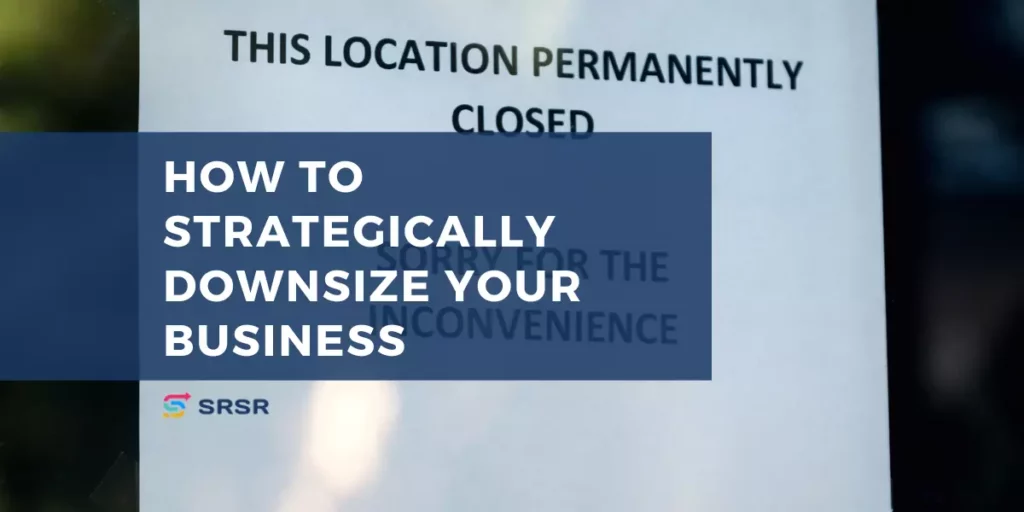While it may seem counterintuitive to many new entrepreneurs, many experts argue that in some challenging economic times or similar turbulence, strategically downsizing your business is the best way to stay viable and achieve success. If you are already confused, don’t worry, we’re going to dig deep into what it means to strategically downsize, or “right-size” your business to be better positioned for future success. We’re going to take a comprehensive look at not only the potential reasons for a downsize, but when it may be the right time, the pros and cons, various implementation strategies, and more.
Reasons to downsize your business
Downsizing your business may seem like the last thing you’d want to do, but it can end up being what saves your business. Here are some of the biggest reasons that you may want to consider downsizing your business:
- As businesses grow, they also tend to become much more complex and oftentimes difficult to manage. Downsizing can help you streamline processes overall and boost general efficiency.
- When a business cuts back on its expenses, it can significantly improve its bottom line. This may allow you to redirect those funds to more strategic areas of the business.
- Downsizing can help your business adapt during market changes, and in some markets, you may have to do so in order to remain competitive, or in the face of reduced demand.
- Focus on the core business, and when you eliminate the various non-essential components, you’ll be more able to focus that dedication elsewhere.
When is the right time to downsize your business?
One of the most important things to understand, regarding your potential strategic downsizing, is that there are signs that you can watch for that can indicate it may be time to cut back. Identifying the best time for your downsizing strategy can be critical for the success of the operation.
First, you may notice declining revenue levels. If your revenue has been steadily decreasing, you may find that it’s time to reevaluate your overall business strategy, possibly considering downsizing. Also, if you are running relatively inefficient operations as a result of being overly complex, or if you’re struggling to manage your workforce efficiently, downsizing may be perfect.
Market shifts are another factor that you should keep a close eye on since market trends and other changes that can affect your business might require you to downsize to stay competitive. Also, if you’re experiencing a loss of profitability or are struggling to stay profitable.
Pros and cons of downsizing your business
Before you make any final decisions, take a look at the ups and downs of a move of this magnitude.
Pros
- Significant cost savings: Downsizing helps you reduce costs which can have a dramatic effect on profitability.
- Increased efficiency: Streamlining organizational processes can result in more efficient operation, which also affects profitability.
- Focus on core competencies: After downsizing, many business owners find it easier to focus more on the critical components of the business, which improves chances for long-term success.
Cons
- Talent loss: During downsizing operations, there are frequent layoffs, which can lead to the loss of priceless employee skill sets and interpersonal dynamics.
- Decreased morale: The downsizing process can be intensely emotionally and psychologically taxing for many, which leads to a diminished morale level.
- Potential negative reputation: Depending on how the process itself is managed, downsizing may have a significant negative effect on its reputation, which causes ripples in customer loyalty and hampers future growth.
Strategy for downsizing your business

When it comes to a strategic downsizing operation, the process itself can seem daunting, but if you follow these steps you’ll have an actionable roadmap to downsize your business.
Evaluate your current situation
First, you’ll need to deeply analyze your financials, operations, and overall market position to figure out where your business stands and to identify areas that can be downsized. Conduct a thorough assessment of the individual strengths, weaknesses, opportunities, and threats, also called a SWOT analysis to gain a deeper, more significant understanding of your organization’s current situation and areas that can be improved.
Develop a clear plan
Create a comprehensive plan that outlines the entire downsizing process, and includes things like the expected timelines, goals, and the roles of key stakeholders. Ensure that specific milestones and clear, measurable objectives are used to track the progress of the downsizing. This plan should be communicated to employees to help keep them engaged and informed.
Reduce staffing
If needed, restructure and reduce your overall workforce by eliminating non-essential positions, and consolidating roles where possible. In most cases, this is done via layoffs, but there are also other options like attrition and voluntary incentive packages. Your decision should be strategic, and you should aim to retain high-performing employees and those with critical or difficult-to-replace skills. Consider retraining opportunities for employees who want to expand their reach.
Move to a smaller space
Sometimes your current office or facility will have more space than necessary to operate. In this case, you may want to consider relocating to a smaller and more cost-effective location. This can reduce common overhead costs like rent, utilities, and facility maintenance. When seeking a new space, check the accessibility as well as the distance to various clients and other critical parties.
Pause or eliminate non-essential projects
Assess or reevaluate ongoing initiatives and projects, and determine if there are any that are not mission-critical. If so, pause or even eliminate these projects to free up resources for other, more important goals. This also serves to streamline operations and reduce distractions.
Outsource or automate tasks
Even though many tasks cannot be eliminated outright, you might be able to outsource them or automate them completely. Freelancers or other specialized service providers will be able to handle almost any task that you need to be done. Be it accounting, marketing, or of course, IT support.
Renegotiate contracts and agreements
Review current contracts with suppliers, vendors, and other service providers to potentially identify areas for improvement and cost reduction. Renegotiate terms, and potentially explore alternate providers that may offer more competitive rates.
Streamline processes and workflows
If there are any areas of inefficiency or unplanned redundancy in your processes or workflows. If so, create process improvements like leveraging lean methodologies, or implementing project management best practices. This can help lower waste and boost cash flow.
Optimize inventory management
Improve your inventory management by properly implementing a JIT or just-in-time, approach to inventory. This means ordering and receiving new inventory only as needed, which cuts back on storage costs and waste and boosts cash flow.
Monitor and adjust
Continually monitor the impact of your downsizing efforts on your business’s overall performance, and make adjustments as necessary to maintain success. This will require regular progress review, and adapting your strategy
How to design layoff guidelines when downsizing your business
There is no easy way to lay off employees, but when you stick to these simple guidelines, you’ll be much better equipped to handle the need for layoffs during downsizing.
1. Develop a clear rationale
Before you make any official announcement of layoffs, be sure you have a coherent and clear rationale for downsizing that you can relay to your employees. This will help them understand the reasons, and why the decisions were made.
2. Be transparent
Make an effort to keep your employees fully informed during the entire process, as well as about any changes to the plan. This will help them grow to trust you and reduce their anxiety.
3. Treat employees fairly
Develop an objective, fair, selection process that determines which employees will be laid off. This could be based on various factors such as tenure, performance, and more. Be sure you stick to all federal regulations.
4. Offer support
Providing resources and support to employees affected by the change, such as job search assistance, resume writing help, and even severance packages. This can ease the transition significantly, and demonstrate that you value their contributions.
5. Manage the remaining workforce
Once the downsizing process is complete, make sure you dedicate ample focus to rebuilding morale and maintaining a profitable level of productivity. Ensure that everyone is on the same page regarding the company’s vision and mission.
The Psychological Impact of Downsizing and How to Mitigate It
There is a considerable psychological impact when announcing a downsizing initiative, and for those who stay in the company, there are some simple steps that can be taken to help minimize the negative effects.
First, make sure you communicate openly, honestly, and consistently, and be as transparent as possible about the reasons for the downsizing. Also, be empathetic, and show that you understand and have compassion for the feelings and concerns of your employees. When possible, provide resources like counseling, stress management, and similar mental health resources to help them cope with the changes.
Finally, do everything you can to maintain a positive work environment. This can be something as simple as celebrating achievements or providing opportunities for personal and professional development.
Rebuilding After You Downsize Your Business

After downsizing, it’s critical for a business to place an emphasis on rebuilding its brand and making it stronger and more resilient. Here are some quick tips to help you achieve that:
- Seriously reconsider your current business plan, and identify areas for improvement
- Establish clear, realistic goals
- Develop a strong company culture that promotes honesty, collaboration, and innovation
- Invest in employee development, including skilling initiatives to help your employees grow professionally and personally
- Monitor your progress and conduct regular reviews of the performance
Assessing the Effectiveness of Your Downsizing Strategy
To ensure that your strategic downsizing has the desired effect, you’ll need to dedicate substantial focus and attention to determining if the measures were successful.
Some of the key metrics that you’ll want to consider will include financial performance indicators like profitability, revenue, and cost savings. You should monitor operational efficiency as well, watching for improvements in processes and workflows. Employee productivity, engagement, and satisfaction are also great indicators to watch to determine if morale or work output has been maintained or whether it’s changed.
Strategies for Growth After You Downsize Your Business

Don’t forget that your strategic downsizing is temporary, and with that in mind, you should already be building a plan for how your business will grow and succeed in the weeks, months, and years after a downsizing move. Once you’ve achieved a more cost-effective operation, it’s time to focus on growth.
Begin to explore new opportunities in your immediate area, to expand into. This can be new markets entirely, or simply new customer segments. Then begin developing products or services that will complement your existing offerings, or cater to emerging customer needs. Eventually, you’ll need to develop strategic partnerships with other businesses that complement your offerings, expand your customer or market reach, or even grant access to new technologies or resources.
You should also make a concerted effort to improve your existing customer experiences, not only in customer service but personalization and user experience as well. Lastly, don’t forget to make sure your online presence and digital marketing efforts are fully optimized to reach a broader audience and drive core growth. Leverage social media, content marketing, and even paid advertising to grow brand awareness and foster lead growth.
Strategy to Downsize your Business – The Importance of Agility and Adaptability
The decision to strategically downsize your business is a significant and complex one, but it’s also one of the decisions that can be the key to unlocking your organization’s long-term success. Throughout the entire process, it’s critical to remember that the agility and adaptability you’re building during this period are vital for businesses that hope to remain relevant in the rapidly changing business environment. If you’ve decided that strategic downsizing is what your organization needs to do to stay healthy and viable in difficult times, you should take a look at our post on the benefits of an asset sale vs. a stock sale.

